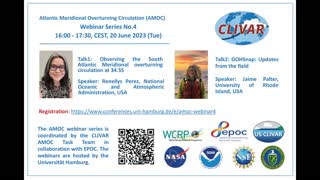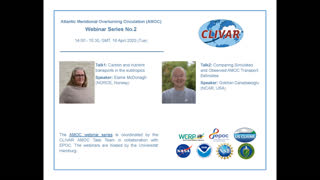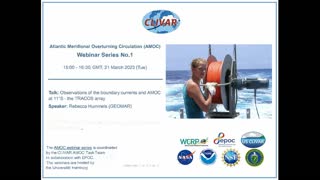Freshwater and AMOC in the North Atlantic Subpolar Gyre & The AMOC volume transport time series at 47N - Prof. Fiamma Straneo, Prof. Monika Rhein - Universität Hamburg
- Lecture2Go
- Videokatalog
- F.6 - Mathematik, Informatik, Naturwissenschaften
- Sonstiges
- AMOC Webinar Series
Videokatalog
1211 Aufrufe
23.05.2023
Freshwater and AMOC in the North Atlantic Subpolar Gyre & The AMOC volume transport time series at 47N
Title: Freshwater and AMOC in the North Atlantic Subpolar Gyre
Speaker: Fiamma Straneo (Scripps Institution of Oceanography, USA)
Abstract:
Increasing freshwater discharge from the loss of Arctic sea-ice and from melting of the Greenland Ice Sheet has the potential to affect the AMOC by reducing dense water formation. In addition to these longer term trends, episodic release of freshwater from the Arctic (e.g. Great Salinity Anomalies) cyclically result in a modification of the stratification, dense water properties and, at times, a temporary slow down or shut down of convection. Here, I present some recent observation-based studies as part of the OSNAP (Overturning in the Subpolar North Atlantic Program) Program that provide insight into some of the processes and dynamics that are responsible for the spreading and mixing of freshwater. Specifically, I will present recent findings related to the circulation and spreading of Greenland meltwater, to the circulation and impact of the latest GSA in the Subpolar North Atlantic and, finally, a baseline estimate for the fraction of Arctic freshwater export that is entrained in the AMOC. Collectively, these studies point at the need to understand the processes that govern the freshwater transport and transformation before we can model their long-term impact on the AMOC.
Title: The AMOC volume transport time series at 47N
Speaker: Monika Rhein, (IUP-MARUM, University Bremen)
Abstract:
The AMOC in models and in observations disagree on many aspects. Here we calculate the AMOC volume transport at 47N (the NOAC array) from observations only, combining moorings at the western and eastern boundaries, PIES in the interior, altimetry and the ARMOR3D data set. The mean AMOC transport from 1993 – 2018 is 17.2 Sv, with no significant long-term trend. The low pass filtered AMOC is significantly correlated with the RAPID AMOC at 26N with r = 0. 53− 0. 71 (depending on the filtering method). The correlation increases to r = 0. 72–0. 84 when 47N leads by 10 months. This finding either points to an extended subtropical regime reaching farther north than anticipated before or challenges the notion that the subtropical and subpolar regimes are decoupled on inter-annual timescales.
Please note that the talk "Simulation-based approaches for quantitative observing system design"
by Patrick Heimbach (University of Texas at Austin, USA) was cancelled in this webinar.
---
The AMOC ( Atlantic Meridional Overturning Circulation) Webinar Series gives an overview and assessments of the current AMOC observing systems. Overview: https://www.clivar.org/amoc-webinar-series Workshop on Meeting AMOC Observation Needs in a Changing Climate: https://www.clivar.org/events/workshop-meeting-... The AMOC Webinar Series is organised by the CLIVAR AMOC Task Team in collaboration with the EU-Project EPOC, coordinated at the UHH.
---
The AMOC ( Atlantic Meridional Overturning Circulation) Webinar Series gives an overview and assessments of the current AMOC observing systems. Overview: https://www.clivar.org/amoc-webinar-series Workshop on Meeting AMOC Observation Needs in a Changing Climate: https://www.clivar.org/events/workshop-meeting-... The AMOC Webinar Series is organised by the CLIVAR AMOC Task Team in collaboration with the EU-Project EPOC, coordinated at the UHH.
Technischer Support
Bitte klicken Sie auf den nachfolgenden Link und füllen Sie daraufhin die notwendigen Felder aus, um unser Support-Team zu kontaktieren!
Link zu der RRZ-Support-Seite




